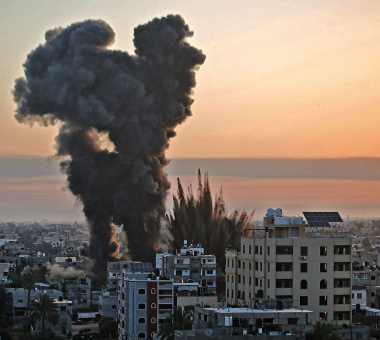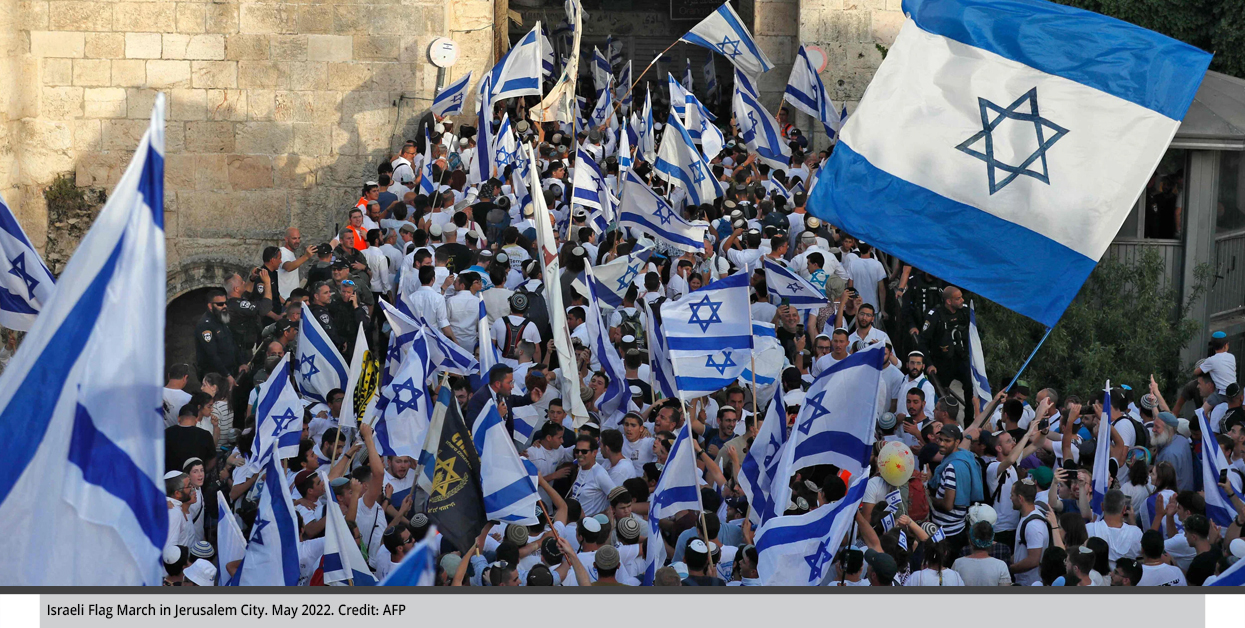Another Round of Escalation to Change the Equation of the “Unification of the arenas”
This paper discusses the recent escalation between the Al-Jihad al-Islami and Israel, which ended with the announcement of a ceasefire between the two parties on May 13. The paper also examines the ““Unification of the arenas”, strategy launched by the Al-Jihad al-Islami in mid-May 2021, as well as Israel’s efforts to dismantle this strategy by adopting a “disintegration of arenas” strategy.
by Hazem Salem Dmour
- Release Date – May 14, 2023

The truce announced between Israel and Al-Jihad al-Islami on May 13 was followed by a state of calm in the Gaza Strip despite a military escalation on May 9 when Israel carried out a series of assassinations against military commanders in the Jerusalem Brigades, the armed wing of the Al-Jihad al-Islami Movement, that culminated on May 11 when Israel and the Al-Jihad al-Islami exchanged tit-for-tat shelling.
A New Round of Escalation
The latest escalation came less than a year after the August 2022 round of escalation between al-Jihad al-Islami Movement and Israel. The escalation also comes at a time when the Israeli and Palestinian arenas are witnessing several transformations, as Al-Jihad al-Islami is frequently engaging in an escalation with Israel in a general context of tensions between Israel on one hand versus Iran and the armed groups affiliated with it on the other.
The escalation involved rockets launched from Lebanon and Syria towards Israel. Israel claims the Lebanese Hezbollah is responsible for the bombing in the Megiddo crossroad. The Israeli army shot down a drone that came from Lebanon and launched successive strikes that targeted Iranian military infrastructure in Syria, causing material damage, as well as casualties and injuries amongst Iranian military personnel.
In addition, there is a high pace of escalation in the West Bank, whether in terms of Israeli incursions into West Bank towns, or vehicular attacks and shootings carried out by Palestinians.
On the other hand, Israel is facing one of its most complex political and judicial crises after Israeli Prime Minister Benjamin Netanyahu’s government tried to introduce amendments to the judicial system. The amendments were suspended under pressure of public opinion despite objections from the government coalition.
This crisis raised concerns regarding the fracture of this coalition. A survey conducted by Professor Camille Fox for Israel’s Channel 13 News in April indicated that Netanyahu’s Likud Party would lose more than a third of its parliamentary seats if early Knesset elections are held. The latest escalation was also accompanied by a state of anticipation as the annual Israeli Flag March scheduled for May 18 may create a new phase of the crisis.

Unification of the arenas and Changing the Rules of the Game
The new significant development in Israel targeting the Al-Jihad al-Islami Movement is Tel Aviv’s quest to break the “Unification of the arenas” strategy the movement launched in May 2021 following the assassination of its military commander in Gaza, Tayseer Jabari. This strategy has evolved in light of several important indicators, including:
- Al-Jihad al-Islami Secretary-General Ziad Nakhaleh admitted in October 2022 that “one of the biggest mistakes of my life” was accepting a ceasefire with Israel in August despite his movement’s ability to continue fighting for several weeks with the same intensity and firepower.
Nakhaleh also emphasized the strategy that links the Gaza Strip with the West Bank and the internal Palestinian situation with the external; connecting arenas with each other; maintaining communication with the Yemeni movement; and strengthening the “Al-Quds Brigades” with new leaders and a thousand fighters.
- Launching missiles from the Gaza Strip, Lebanon, and Syria towards Israel in April 2023 has coincided with an escalation on the ground in the West Bank, following recurrent incursions by settler groups into the courtyards of Al-Aqsa Mosque.
- The May 9 announcement by the Israeli Shin Bet security service that it had dismantled a military cell affiliated with the Al-Jihad al-Islami in the West Bank city of Jenin that was preparing to fire rockets at Israel. The cell was led by Al-Jihad al-Islami leader Tariq Ezz al-Din, who was assassinated. Another cell, uncovered in Ramallah, was planning to fly attack drones into Israel. Plans to launch rockets and attack drones against Israel was a qualitative shift in al-Jihad al-Islami’s strategy.
All the aforesaid facts indicate that Israel, to escape the sphere of threats it faces, will move towards adopting a strategy of “arenas disintegration” to confront the other side’s strategy of “Unification of the arenas.” Components of that strategy involves:
- Destroying Al-Jihad al-Islami’s military infrastructure in the Gaza Strip, along with efforts to prevent its attempts to transfer the missiles test to Judea and Samaria.
- Prosecuting and neutralizing leaders of Al-Jihad al-Islami’s military operation in the Gaza Strip and the West Bank, as they were attempting to act in foreign arenas like Syria and Lebanon.
- Sending direct warning messages to Iran’s allies in Syria and Lebanon, especially Hezbollah, on the consequences of engaging in military confrontation. Such messages will carry an indirect warning to Iran itself.
- Ensuring the continuation of a tacit understandings with the Hamas leadership that it will not interfere in military confrontations. Such understandings were reached through political, security, and financial pressures; threats to assassinate Hamas’s leaders; and the threat of changing the economic facilitations for the movement of crossings and goods to and from the Gaza Strip.
- Working on lowering the threshold of ceasefire conditions from the armed Palestinian factions after each round of confrontation, as well as Israel imposing new conditions that serve its strategy of fragmenting the arenas. In the ceasefire negotiations, the Palestinian factions demanded that Israel stop its assassinations. However, Israel’s Channel 12 reported that the signed truce agreement does not include a halt to assassinations in the Gaza Strip.
Finally, it can be said that the development of the “Unification of the arenas” strategy began to enlarge the threats against Israel, especially with regards to the growing military capabilities of the Al-Jihad al-Islami Movement and the integration of action and reaction between the two Palestinian arenas, the West Bank and the Gaza Strip, as well as arenas in Syria and Lebanon.
There is no sign indicating Hamas’s ability to ensure calm in the Gaza Strip via its tacit understandings with Israel. In addition, Al-Jihad al-Islami has branched into smaller factions, which complicates the process of containing it in the West Bank, especially in light of the support by Iran and its allies for the al-Jihad al-Islami. This prompted Israel to adopt a policy of “fragmentation of arenas.”
Although the current round of military confrontation between Israel and Al-Jihad al-Islami came to an end, a final exit from the confrontation sphere will not be achieved. This is due to the overlapping causes and factors of escalation between Israel and the al-Jihad al-Islami, and the escalation extension to foreign events and contexts that are more broadly related to the Israeli-Iranian escalation.

Hazem Salem Dmour
General Manager / Specialized Researcher in International Relations and Strategic Studies
 العربية
العربية